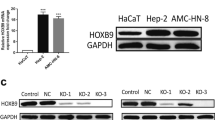Summary
F-box proteins, a type of substrate-recognition complexes consisting of SKP1-cullin 1-F-box protein (SCF) E3 ligase, can critically affect many cellular processes because of the ubiquitylation and subsequent degradation of target proteins. This study investigated the effect of FBXO22 on melanoma angiogenesis, migration, and invasion. Results showed that FBXO22 staining intensity was increased in malignant melanoma (MM) compared with that in skin tissue (P˂0.001). The percentage of high FBXO22 expression in MM (74.3%) was markedly higher than that in paracancerous and skin tissues (0%) (P˂0.001). FBXO22 was also overexpressed in MM tissues compared with that in normal skin tissues. FBXO22 knockdown in vitro inhibited MM cell migration, invasion, and angiogenesis (P < 0.001). In vivo studies confirmed that using nude mice with knocked down FBXO22 reduced the formation of blood vessels and decreased the positive rate of CD31 (P < 0.05). HIF-1α expression varied with FBXO22, indicating that FBXO22 regulated the expression of HIF-1α and VEGFA and that FBXO22 was a regulator of HIF-1α and VEGF for the control of tumor angiogenesis. In conclusion, FBXO22 promoted the migration and invasion of tumor cells and melanoma angiogenesis via HIF-1α upregulation. This study demonstrated that FBXO22 knockdown suppressed tumor progression and metastasis, suggesting that FBXO22 might be developed as a novel target for treating patients with MM.





Similar content being viewed by others
References
Siegel RL, Miller KD, Jemal A (2015) Cancer statistics, 2015. CA Cancer J Clin 60(5):277–300
Eggermont AM, Spatz A, Robert C (2014) Cutaneous melanoma. Lancet 383(9919):816–827
Balch CM, Gershenwald JE, Soong S, Thompson JF, Atkins MB, Byrd DR, Buzaid AC, Cochran AJ, Coit DG, Ding S (2009) Final version of 2009 AJCC melanoma staging and classification. J Clin Oncol 27(36):6199–6206
Korn EL, Liu PY, Lee SJ, Chapman JAW, Niedzwiecki D, Suman VJ, Moon J, Sondak VK, Atkins MB, Eisenhauer EA (2008) Meta-analysis of phase II cooperative group trials in metastatic stage IV melanoma to determine progression-free and overall survival benchmarks for future phase II trials. J Clin Oncol Off J Am Soc Clin Oncol 26(4):527–534
Orgaz JL, Sanzmoreno V (2013) Emerging molecular targets in melanoma invasion and metastasis. Pigment Cell Melanoma Res 26(1):39–57
Skaar JR, Pagan JK, Pagano M (2014) SCF ubiquitin ligase targeted therapies. Nat Rev Drug Discov 13(12):889–903
Z W PL, H I WW (2014) Roles of F-box proteins in cancer. Nat Rev Cancer 14(4):233
Luo Z, Zhang X, Zeng W, Su J, Yang K, Lu L, Lim CB, Tang W, Wu L, Zhao S (2016) TRAF6 regulates melanoma invasion and metastasis through ubiquitination of Basigin. Oncotarget 7(6):7179–7192
Wu B, Liu Z, Cui J, Yang X, Jing L, Zhou Y, Chen Z, Jiang J (2017) F-box protein FBXO22 mediates Polyubiquitination and degradation of CD147 to reverse cisplatin resistance of tumor cells. Int J Mol Sci 18(1):212
Nys K, Maes H, Dudek AM, Agostinis P (2011) Uncovering the role of hypoxia inducible factor-1α in skin carcinogenesis. Biochim Biophys Acta Rev Cancer 1816(1):1–12
Bedogni B, Welford SM, Cassarino DS, Nickoloff BJ, Giaccia AJ, Powell MB (2005) The hypoxic microenvironment of the skin contributes to Akt-mediated melanocyte transformation. Cancer Cell 8(6):443–454
Kuphal S, Winklmeier A, Warnecke C, Bosserhoff AK (2010) Constitutive HIF-1 activity in malignant melanoma. Eur J Cancer 46(6):1159–1169
Sun B, Zhang D, Zhang S, Zhang W, Guo H, Zhao X (2015) Hypoxia influences vasculogenic mimicry channel formation and tumor invasion-related protein expression in melanoma. Cancer Lett 249(2):188–197
Giatromanolaki A, Sivridis E, Kouskoukis C, Gatter KC, Harris AL, Koukourakis MI (2003) Hypoxia-inducible factors 1alpha and 2alpha are related to vascular endothelial growth factor expression and a poorer prognosis in nodular malignant melanomas of the skin. Melanoma Res 13(5):493–501
Hou P, Li L, Chen F, Chen Y, Liu H, Li J, Bai J, Zheng J (2018) PTBP3-mediated regulation of ZEB1 mRNA stability promotes epithelial-mesenchymal transition in breast Cancer. Cancer Res 78(2):387–398. https://doi.org/10.1158/0008-5472.CAN-17-0883
Tan MM, Lim H, Harper JW (2011) SCFFBXO22 regulates histone H3 lysine 9 and 36 methylation levels by targeting histone demethylase KDM4A for ubiquitin-mediated proteasomal degradation. Mol Cell Biol 31(18):3687–3699
Tian X, Dai S, Sun J, Jin G, Jiang S, Meng F, Li Y, Wu D, Jiang Y (2015) F-box protein FBXO22 mediates polyubiquitination and degradation of KLF4 to promote hepatocellular carcinoma progression. Oncotarget 6(26):22767–22775
Hynes RO (2003) Metastatic potential: generic predisposition of the primary tumor or rare, metastatic variants-or both? Cell 113(7):821–823
Valastyan S, Weinberg RA (2011) Tumor metastasis: molecular insights and evolving paradigms. Cell 147(2):275–292
Semenza GL (2007) Hypoxia-inducible factor 1 (HIF-1) pathway. Sciences Stke signal transduction knowledge environment 2007 (407):cm8
Ke Q, Costa M (2005) Hypoxia-inducible Factor-1 (HIF-1). Crit Care Med 33(5):423–425
Funding
This study was funded by grants from the National Natural Science Foundation of China (No. 81672845, 81872304), the Project of Invigorating Health Care through Science, Technology and Education from Jiangsu Province (ZDRCC2016009), the Priority Academic Program for the Development of Jiangsu Higher Education Institutions (Public Health and Preventive Medicine).
Author information
Authors and Affiliations
Corresponding authors
Ethics declarations
Conflict of interest
The authors have declared that no competing interest exists.
Ethical approval
All experiments involved in this study were approved by both the Institutional Review Boards of Xuzhou Medical University and the Ethics Committee of the above hospital.
Informed consent
Each patient provided a written informed consent prior to the study.
Additional information
Publisher’s note
Springer Nature remains neutral with regard to jurisdictional claims in published maps and institutional affiliations.
Yufan Zheng and Hairong Chen contributed equally to this work.
Rights and permissions
About this article
Cite this article
Zheng, Y., Chen, H., Zhao, Y. et al. Knockdown of FBXO22 inhibits melanoma cell migration, invasion and angiogenesis via the HIF-1α/VEGF pathway. Invest New Drugs 38, 20–28 (2020). https://doi.org/10.1007/s10637-019-00761-z
Received:
Accepted:
Published:
Issue Date:
DOI: https://doi.org/10.1007/s10637-019-00761-z




